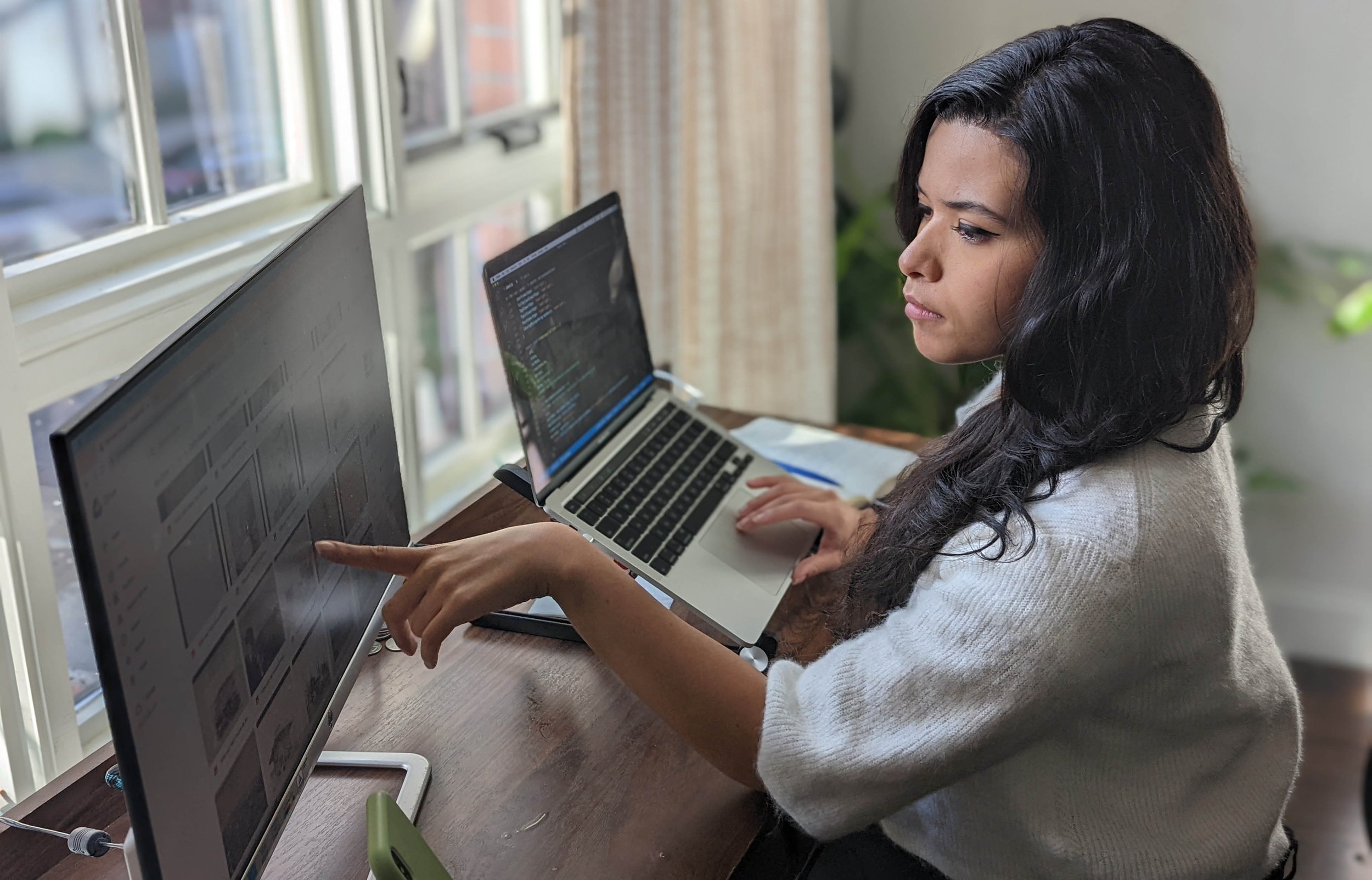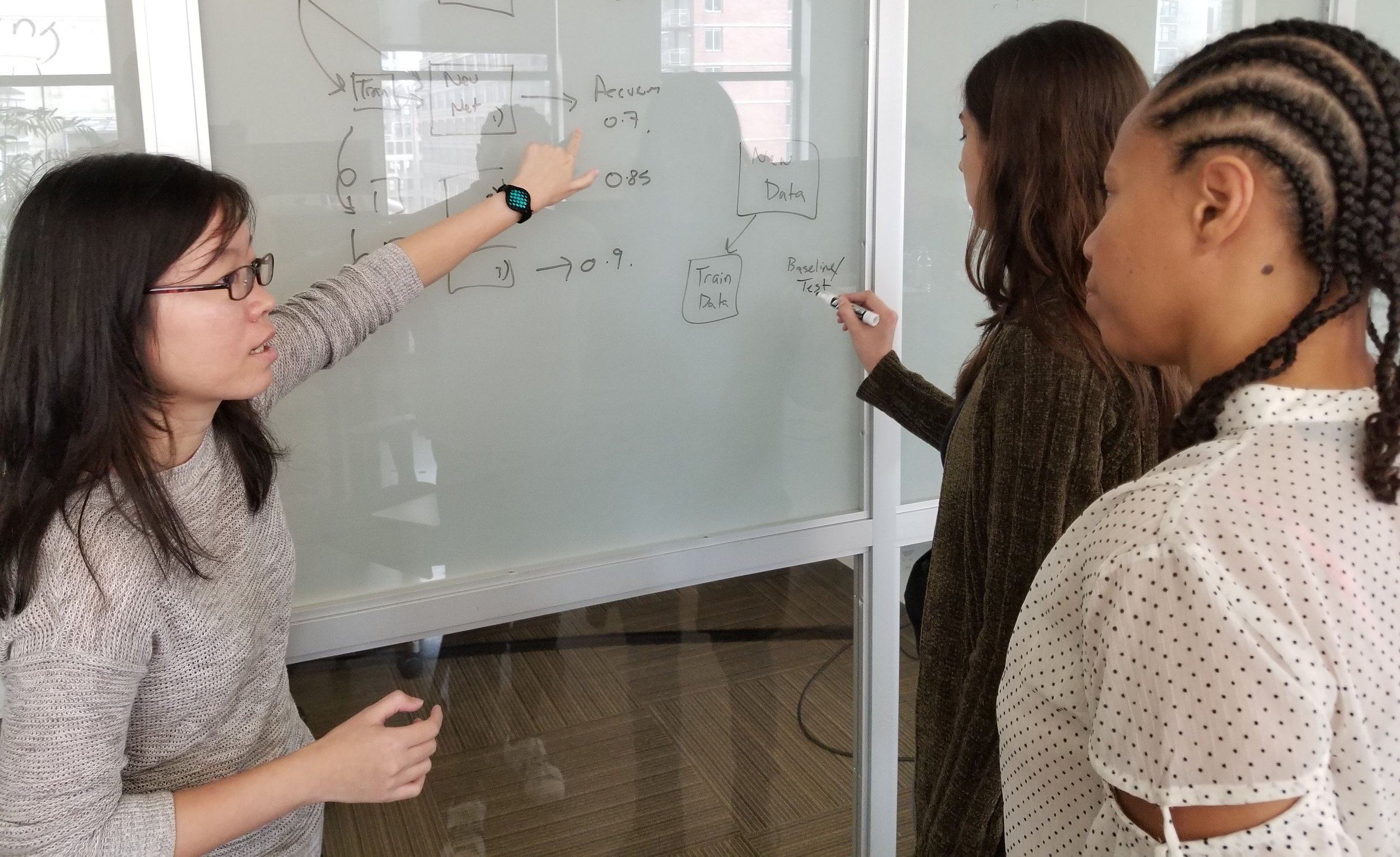It’s been nearly ten years since Thoughtworks started on a journey to bring the arts in-house. In 2013, Andrew McWilliams, a Thoughtworks lead technical consultant and artist, launched the Hardware Hack Lab, an open meeting space and demo exchange. A year later that was joined by Art-A-Hack, a curated team-based art practice—and then in 2016, the Thoughtworks Arts Residency, which serves individual artists as an incubator for innovative and provocative ideas.
While the three programs that make up Thoughtworks Arts: A Global Research and Innovation Lab differ in their structure and duration, they all promote a curiosity about what happens when artists and engineers create together.
A Thoughtworks Arts residency explores bias in AI and neural networks
Technologist and new media artist Nouf Aljowaysir applied for a 16-week Thoughtworks Arts residency in 2019. “The theme was synthetic media created by artificial intelligence or generative neural networks. I had just finished a huge commercial brand project dealing with AI, but I wanted to understand it from a more personal perspective.”
“I immigrated to this country [from Saudi Arabia] at a very young age,” said Aljowaysir. “Themes of identity have always been swirling in my mind, like, Who am I? Where do I belong? So I submitted a very raw piece about that confusion and how I wanted to be at peace with it through my artwork.”
Artist Nouf Aljowaysir working remotely on her Thoughtworks Arts Residency project, "Salaf", 2020
Photo: Nouf Aljowaysir
What developed over the course of her residency into “Salaf” (Arabic for “ancestor”), explored Aljowaysir’s family history. Working with machine learning and neural networks, Aljowaysir and her Thoughtworks partners examined how AI systems interpret non-Western photo databases. They found stereotypes that threatened her culture’s collective memory, and bias in the data that had persisted for more than five generations.
At one point a developer on the project suggested using commercial data for facial recognition and generation. Aljowaysir recalls that he was eager to plug into something already available and tested.
“I was trying to create my own nuanced data set. And I said to him, ‘I don’t know about that.’ But then I thought, ‘Okay, why not? Let’s try it.’ And so we tried it out and we found a lot of bias. For example, it didn’t recognize a hijab, and got all the features wrong. Or it would just show a lot of bias towards Western faces. That was a key moment.”
“It’s interesting,” continued Aljowaysir, “because developers are learning about creative expression but they’re also experiencing the ethical implications of these technologies, which they don’t necessarily learn through their work.”
Generated output using the styleGAN AI model from Nouf Aljowaysir's "Salaf", 2020
Photo: Nouf Aljowaysir
Artists and developers from across the globe create together
That mutual exploration is the goal of Thoughtworks Arts. The residency connects artists with developers who are experts in the hardware or software the artist plans to use, or is curious to know more about.
Developers and artists may live in the same city, and work together in person, or be separated by oceans. According to McWilliams, a truly global reach is an asset that Thoughtworks, with 48 offices in 17 countries, embeds into their residency program.
“We have people contributing to projects right now in Chile and Brazil and North America and the UK, Germany, Europe, India and China—often working together on a common project for an artist who is in yet another region. When you bring these groups of people together from different backgrounds it provides a richer experience for the artists. That’s one of the things they’ll often comment on. They’ve never worked with such an international group.”
But McWilliams and his Thoughtworks Arts co-director, Ellen Pearlman, a new media artist, critic and curator, are very aware that an artist’s creative and emotional growth—along with technical proficiency—is just as important to the success of their project.
“You have the tech, you have the expertise—now, what do you want to say?” said Pearlman. “As an artist, it’s your job to understand and transform those signs and symbols through the use of technology, to create an experience that’s readable to people without expertise. That’s what I worked with Nouf on. It was a hard process for her, because her piece required a lot of vulnerability.”
At the Cooper Hewitt Museum: Thoughtworks Arts co-director Andrew McWilliams, resident artist Karen Palmer, Thoughtworks Arts communications manager Paige King, and Thoughtworks Arts co-director Ellen Pearlman, 2019.
Photo: Thoughtworks
The value of a company-wide commitment to the arts
For Chris Murphy, CEO of Thoughtworks North America, investing in an arts residency makes perfect sense for a company that thrives on questioning assumptions.
“When you see breakthrough innovation, it tends to happen on the edge of things, on the edge of chaos,” said Murphy. “And that’s because it involves rethinking how something is looked at or perceived or thought about from an entirely new perspective.”
“Thoughtworks Arts brings together technologist and artist at the intersection of sociological challenges. It says, ‘What might happen if we apply this technological innovation to this pressing social challenge—and connect this artist, who comes from a very different background, with this set of technologists?’”
Artist Karen Palmer with Thoughtworkers Sofia Tania and Angelica Perez, 2017
Photo: Thoughtworks
But how do you measure that value? Companies are compelled by investors and shareholders to account for how they spend their capital. The problem is how to balance obvious and easier-to-justify quantitative measures with the more intangible and qualitative ones.
Murphy has no trouble laying out a set of values worth investing in, but he also questions if they can, and should, always be measured.
“It may be that someone joins us because of their exposure to Thoughtworks Arts. It may be that someone stays with us because of their experience with Thoughtworks Arts. That happens quite regularly, and it’s important in the war for talent. It may be that someone comes up with a brilliant new idea because of their work with Thoughtworks Arts. That means they’ve got a new perspective that adds additional value to our clients. It may be a client sees what we are doing with Thoughtworks Arts, and it reinforces in their mind our technology leadership and the way we bring different things together as an innovation company. And it may be that we get brand exposure or name recognition because of our work with Thoughtworks Arts.”
“Can we draw out the value which Thoughtworks Arts has added in each instance and give it a definitive, quantitative value?” said Murphy. “I’m not sure we can. But as the leader of the North American business, I can say we would be a lesser organization if we didn’t have Thoughtworks Arts.”
Art-making reinforces Thoughtworks’ social purpose
Creating art has always been one of the most powerful ways for human beings to make sense of themselves and their world. Art holds up a mirror to our desires, our actions and our ideals. It carves out a space where we can imagine different realities; it reveals our obligations to society and to one another.
For Thoughtworks, which has a prominent commitment to social justice and the ethical use of technology, inviting artists to be residents and partners reinforces those ideals.
“Thoughtworks Arts illustrates this in a very visual way—because it’s hard to describe culture with language,” said McWilliams. “But Thoughtworks Arts tells you something about the company, it tells you something about culture, and that translates into an alternative form of value for clients.”
Resident artist Neil Harbisson with engineer Oryan Inbar and Thoughtworker Kelvin Rojas, 2016
Photo: Thoughtworks
The arts, with their imprecision and messiness and unpredictable nature, would seem to be an unusual fit for a cutting edge technology consulting company. But Nouf Aljowaysir’s residency made it clear to her that all those qualities have a purpose.
“We’re not just good at one thing, we’re good at many things.” said Aljowaysir. “The program’s value for developers is to have a space to be creative, to do something fun, to expand their thinking. How can we be more nuanced individuals than, ‘I’m a programmer. I’m amazing at backend.’”
Isn’t that, by itself, a reminder that we shouldn’t only measure value in time saved, contracts won or money earned?
“There’s something unique about artists,” reflected McWilliams. “There’s something different about a profession in which the boundary isn’t a particular skill, or craft or domain. Other professions have more guardrails around them. But art, in its most authentic form, is free. And that freedom—that trained freedom—enables conceptual leaps and discoveries that are bigger than narrow research propositions. They are about worldviews and windows onto the world. Working with artists is unique.”
- -
Published here on Forbes.com
January 14, 2022






